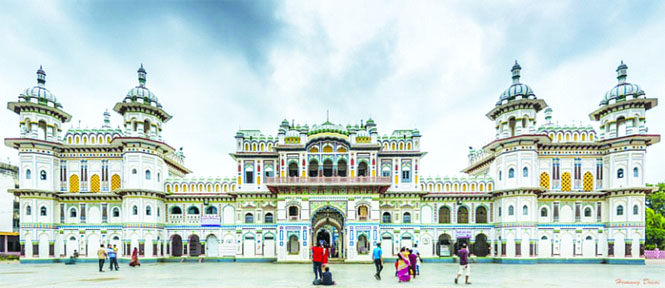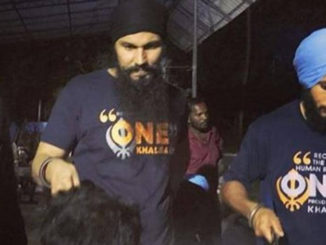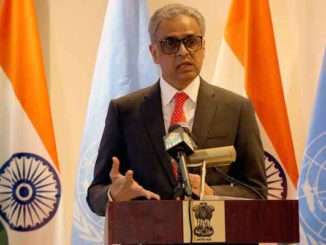
Janaki Temple, the birthplace of goddess Sita, is located in Janakpur, Province No. 2 of Nepal. The temple is famous for Hindu Pilgrims all around the World. Lying in the heart of Janakpur, this temple of goddess Sita is evidence of the proud history of the kingdom of Janak on which several ancient stories are based. Ram Janaki Temple is one of the many UNESCO world heritage sites of Nepal.
The most important historical reference to Janakpur is the Ramayana. As mentioned in the first millennium BC text, present Janakpur was the capital city of the South Asian Kingdom Videha, founded by King Mathava Videgha with his priest Gotama Rahugana when they first crossed the Sadanira (Gandaki) river. They were believed to be the ancestor of King Janak, who also ruled in this Maithali Realm during the Ramayana period, nearly 7000 years ago.
Valmiki’s Ramayana says goddess Sita was found in a furrow while King Janak was plowing the field in his kingdom. Since King Janak had no children, he declared Sita as his daughter and thus, is also known as Janaki (daughter of King Janak). The temple was named after the goddess Sita as Janaki Mandir. Various remnants of 11th and 12th century AD can be found in this temple, and every corner of Janakpur reflects the story of Ram Sita.
The Janaki Mandir is also known as Naulakha Mandir (meaning nine lakhs) as the exact Nine Lakh Rupees was spent in building this temple and occupies an area of 4860 sq. km. It was built by Queen Brish Vanu of Tikamgarh, India, in 1910 AD. It is believed that in 1657, a golden statue of Devi Sita was discovered in the spot where the temple stands today.
This temple is not only the birthplace of Devi Sita but is also the place that carries the pureness of the marriage of Rama and Sita. Also, in this kingdom of King Janak lies where the fossilized portion of the broken bow exists. The bow was the divine of Lord Shiva and has a story related to Rama Sita Marriage. The bow was Shiva Dhanush, also referred to as ‘Pinaka,’ was crafted by Lord Vishwakarma.
Since Lord Shiva gifted Pinaka to King Devarratha of Mithila, who was the ancestor of King Janak, it was there in King Janak’s palace that no one except Sita could lift. Later, King Janak declared that whosoever could lift and string the Shiva Dhanush shall marry Sita.
Many princes from around the World attended Sita’s Swayambara to lift the Pinaka after King Janak’s declaration. None of the attendees were able to lift the bow but Lord Rama. However, the Pinaka was broken when he tried to string it, and people believe that the broken Pinaka’s fossils still lie in the Dhanushadham of Janakpur.
This is how Rama was able to marry Sita because of Shiva Dhanush. The competition of lifting the bow is believed to be held in Rangbhumi Maidan (or Barah Bigha), about 0.5 km away from the temple. Every Sunday in the month of Magh (Jan/Feb), a Makar Mela takes place in Dhanushadham.
Makar Mela is a tradition that has not been broken since the Vedic period, and thousands of devotees visit this place to attend the mela.
In the present, Janaki Mandir territory is the Vivah Mandap situated on the right side of the main temple, where the marriage of Lord Rama and Goddess Sita is said to happen. The vivah mandap shows the marriage ceremony of Rama and Sita in the form of statues.
The Mandap is built in Pagoda Style with four other small temples at each of its four corners. Surrounded by a beautiful garden, the Mandap has the footprints of Lord Rama and Sita.
Surrounded by Maithali arts and culture makes the temple is more special and beautiful. The story of Rajarshi Janak and his daughter Sita, Ram Sita’s marriage, is also portrayed in the Maithali Chitrakala format, which is a beautiful thing to view inside the temple.
The Janaki Temple is made in ‘Mughal’ form, an Indo-Islamic architectural design, and perfect artistry. The temple is in a three-storied structure made entirely with stones and marbles. Altogether, 60 rooms are there in the temple ornamented with colored glass, carvings, and paintings, as well as beautifully framed windows and turrets.
There is two entrance to the temple, east and north side. As one enters pass the 30-meter high arched gate, a shrine with the grand idol of goddess Sita can be seen in the central part of the temple, which is also known as Janaki Mahal. Behind the Janaki Mahal is the Janak Temple devoted to the father and mother of goddess Sita.
There are similar shrines in the temple complex called Sannadhis and have idols of Lord Rama and other statues of Sita, Lakshman, and Urmila. There’s a black stone called Saligram in Janaki temple that King Janak used to worship. Saligram is considered one of the highly powerful stones and is a direct symbol of God Vishnu. A cultural museum on the left side of the temple contains the ancient traditional Mithila dresses and jewelry.
The devotees from India, Sri Lanka, and Nepal visit the temple at various festivals like Ram Navami, Vivah Panchami, Chhat, Holi, and other festivals. The temple priest allows the visitors to offer prayers to gods and goddess idols inside the temple, and Saligram King Janaka worshiped. Source: Vedicfeed





Be the first to comment